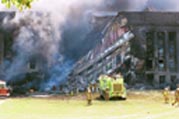 |

|
After the September 11, 2001,
attacks on World Trade Center and
the Pentagon, the United States
military entered into a war against
terrorism worldwide. The President
began the U.S. response in the War
on Terrorism with the stroke of his
pen to seize terrorists' financial
assets and disrupt their fundraising
network. America, joined by allies
|
around the world, is now engaged in a New War…the War
on Terrorism. Unlike most previous conflicts, this New War
is being fought on both domestic and foreign soil.
Deployment of American troops followed the terrorist attacks
on the World Trade Center Towers in New York City and the
attack on the Pentagon in Arlington, VA.
Just minutes after two airliners crashed into the twin towers
of the World Trade Center in New York City, an American
Airlines Boeing 757 hit the west side of the Pentagon at 9:20
a.m. on the morning of September 11, 2001. Over 300
soldiers of the Virginia National Guard were activated to
help with the crisis. Military police, medical personnel and
|

|
engineers were among
those called to active duty.
In the District of Columbia,
Guardsmen of the 372nd
Military Police Battalion
were activated to assist
with traffic control. All
federal buildings were
|
closed after the terrorist attack and, for much of the day,
traffic was kept from crossing bridges into thecity.
In New York City, up to 2,000 troops of the New York
National Guard were called up to provide traffic control in
Manhattan along with other support functions. Military units
also stood ready with Critical Incident Stress Management
and medical logistics support. Members of the Air Guard
flew over the city to set up a protective air cap.
|

|
In October 12, 2000, in Aden,
Yemen 17 sailors were killed
and 39 others were injured as
a result of a terrorist bombing
attack on the USS Cole
(DDG67), which left a 40-foot
by 40-foot hole in the portside
of the Norfolk, Virginia-based
|
destroyer. A 60-foot by 60-foot patch was welded to the hull
of the destroyer before it was off-loaded from Blue Marlin, a
Norwegian heavy transport ship that carried the Cole back to
the United States. In August 1998, U.S. embassies in Kenya
and Tanzania fell under terrorist attacks when both
embassies were bombed. At least 200 people were killed
and about 5,000 were injured in Nairobi, Kenya and 10
people were killed and 74 people were injured in Dar es
Salaam, Tanzania.
In June 1996, a terrorist act killed nineteen American service
members and injured hundreds of other service members
and Saudis when terrorists exploded a massive truck bomb
outside the Khobar Towers housing complex in Dhahran,
Saudi Arabia.
|
|
 |

